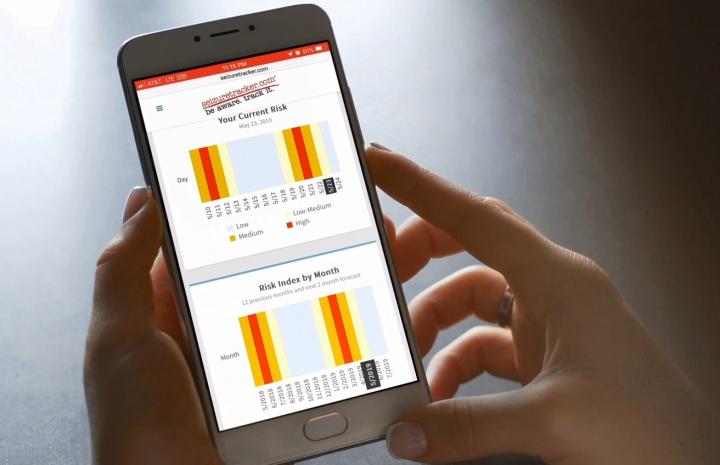Study is first validation for statistics-based tool to better treat patients with epilepsy

Credit: Courtesy of SeizureTracker.com
HOUSTON – (Dec. 4, 2019) – A researcher at Rice University’s Brown School of Engineering and an alumna of her lab have the first validation of their program to assess the risk of seizures in patients with epilepsy.
In a preliminary study, their Epilepsy Seizure Assessment Tool (EpiSAT) proved equally able or better than 24 specialized epilepsy clinicians at using patients’ histories to identify periods of heightened propensity for seizures.
“Epilepsy affects more than 3.4 million people nationwide,” said Rice statistician Marina Vannucci, co-author of the study led by her former student, Sharon Chiang, now a resident physician at the University of California, San Francisco (UCSF) Department of Neurology. “This study could serve as a benchmark case for other diseases or situations that could employ a statistical approach.”
The researchers’ automated machine-learning algorithm correctly identified changes in seizure risk — improvement, worsening or no change — in more than 87% of cases. They achieved those results by analyzing 120 seizures from four “synthetic” diaries and 120 seizures from real seizure diaries gathered by SeizureTracker.com, one of the largest electronic seizure diaries in the world. EpiSAT showed “substantial observed agreement” with clinicians more than 75% of the time, they reported.
The results appear in the journal Epilepsia.
“One challenge in treating people with epilepsy is that, like the chance of rain, there has never been a good way to quantify seizure risk and to determine whether apparent changes in seizure frequency reflect chance or actual improvement or worsening in their clinical state,” said Vikram Rao, chief of the epilepsy division and an associate professor of neurology at UCSF. “The algorithm that Dr. Chiang developed in this study directly addresses that clinical dilemma.”
Clinicians rely on seizure diaries kept by the patients to get a sense of the severity and frequency of the attacks.
“Seizure-counting is one of the oldest indices physicians rely on to monitor the underlying epilepsy burden and assess response to treatment,” Chiang said. “A fundamental challenge is that changes in observed seizure frequency are not necessarily reflective of treatment, but may be due to natural variability.
“Crude estimates of seizure frequency can be misleading, and if misinterpreted as a change in seizure propensity can lead to unnecessary or harmful treatment decisions,” she said.
Matching real patient data to simulated data allowed the team to know with certainty when the algorithm was on target and raised confidence in their ability to analyze patient data, Vannucci said. “The ability to mimic what happens in reality lets us assess the performance of our method,” she said. “We can know for sure whether it recovers the truth.”
“This new publication shows the benefits of a quantitative approach that can guide treatment when deciding whether treatment has been helpful,” said John Stern, a professor of neurology and co-director of the UCLA Seizure Disorder Center and co-principal investigator of the study.
The study follows extensive collaboration by Vannucci and Chiang, who degrees from Rice and Baylor College of Medicine in 2016 and 2018, respectively, through the institutions’ M.D./Ph.D. program. A 2017 paper by the team outlined a method integrating neuroimaging scans to identify patients at high risk of continued seizures before employing invasive surgery that may or may not provide complete relief.
For their work on the 2018 paper that proposed EpiSAT, Chiang won the 2019 Clinical Epilepsia Open Prize, presented by the International League Against Epilepsy.
Vannucci said the team plans to refine EpiSAT by incorporating data from electronic health records. “Including possible covariates could serve as an additional validation of the method,” she said. “The ultimate goal is to see the tool deployed in clinical practice.”
###
Co-authors of the paper are Daniel Goldenholz of Beth Israel Deaconess Medical Center, Boston; Robert Moss of Seizure Tracker LLC, Annandale, Virginia; Zulfi Haneef of Baylor; William Theodore of the National Institutes of Health, Bethesda, Maryland; Jonathan Kleen of UCSF; and Jay Gavvala of Baylor. Vennucci is the Noah Harding Professor of Statistics at Rice.
The National Institutes of Health and National Science Foundation supported the research.
Read the abstract at https:/
This news release can be found online at https:/
Follow Rice News and Media Relations via Twitter @RiceUNews.
Related materials:
Presurgical imaging may predict whether epilepsy surgery will work: http://news.
Statistics method shows networks differ in epileptic brains: http://news.
Marina Vannucci: https:/
Sharon Chiang: https:/
Rice Department of Statistics: https:/
George R. Brown School of Engineering: https:/
UCSF Division of Epilepsy: https:/
SeizureTracker.com: https:/
Images for download:
https:/
CAPTION: Marina Vannucci. (Credit: Jeff Fitlow/Rice University)
https:/
CAPTION: Sharon Chiang. (Credit: Courtesy of Sharon Chiang)
https:/
A study to validate an epilepsy seizure assessment tool relied in part on patient data from a web-based service patients may use to track seizures. (Credit: Courtesy of SeizureTracker.com)
Located on a 300-acre forested campus in Houston, Rice University is consistently ranked among the nation’s top 20 universities by U.S. News & World Report. Rice has highly respected schools of Architecture, Business, Continuing Studies, Engineering, Humanities, Music, Natural Sciences and Social Sciences and is home to the Baker Institute for Public Policy. With 3,962 undergraduates and 3,027 graduate students, Rice’s undergraduate student-to-faculty ratio is just under 6-to-1. Its residential college system builds close-knit communities and lifelong friendships, just one reason why Rice is ranked No. 1 for lots of race/class interaction and No. 4 for quality of life by the Princeton Review. Rice is also rated as a best value among private universities by Kiplinger’s Personal Finance.
Jeff Falk
713-348-6775
[email protected]
Mike Williams
713-348-6728
[email protected]
Media Contact
Mike Williams
[email protected]
713-348-6728
Original Source
https:/
Related Journal Article
http://dx.




